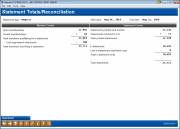Statement Reconciliation / Analysis
| Screen ID: | ISTRDBFM-02 | 
|
| Screen Title: | Statement Totals/Reconciliation | |
| Panel ID: | 5496 | |
| Tool Number: | 825 | |
| Click here to magnify |
Access this screen by selecting the lookup next to a statement period on the first screen of the Statement Reconciliation/Analysis dashboard.
Data is available on this screen based on what was selected on the previous screen. Learn more about the fields on this topic.
Click Style/Insert to view detailed information about the statement styles used for printing and information on statement inserts included in the statement run.